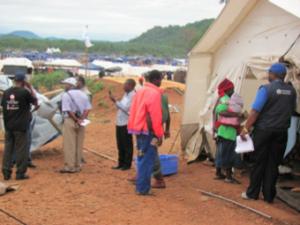WHO Supports 3rd Monitoring Visit to Floods Relocation Camp
Masvingo: 16 March 2014. The National Rapid Response Team (NRRT) conducted a third monitoring and support visit of the Chingwizi relocation camp which houses Tokwe-Mukorsi Dam flood victims. The visit was made at the recommendation of the Inter Agency Coordination Committee on Health (IACCH), with financial and technical support from the Zimbabwe WCO . The NRRT which comprised WHO staff and MoHCC officials was tasked to: Find out to what extent recommendations made during two previous visits were implemented; Monitor the current public health situation at Chingwizi camp site; Monitor current health service provision at the camp; and; Make further recommendations on public health and health care provision.
The team travelled to Masvingo Province on the 12th of March. The entry point was the Provincial Medical Director’s (PMD) office in Masvingo, where the team had a briefing from the PMD on the 13th of March, before proceeding to the relocation camp site. At the camp, the team made observations around the camp, the health facility and the school; carried out interviews of key informants; and examined health facility records. The team also attended the Provincial Civil Protection Coordination Meeting on the 14th of March before returning to Harare.
The NRRT has since compiled its report. The report noted that there were notable improvements as far as public health at Chingwizi relocation site is concerned. However, the conditions remain unacceptable, characterized with overcrowding and poor hygiene. According to provincial health authorities 3,458 families had been relocated to the site by the time of the visit. Other determinants of health such as water, sanitation, food and shelter are still a challenge. Heavy rains which pounded Nuanetsi Ranch and surrounding areas on the night of the 10th of March had worsened the situation. The rains destroyed some of the tents and soaked significant quantities of food.
Health care provision had significantly improved at the camp. Health facility infrastructure had improved through erection of two tents, one 45m2 and another 25m2 donated by WHO. The bigger tent was being used for consultations and deliveries, while the smaller tent was used for staff accommodation. Storage of medicines and other medical commodities was however still poor as these were kept on the floor in a small tent, and exposed to adverse weather conditions. The team also observed that disease surveillance had improved at the camp. The recommendation of the NRRT during its previous visit to put in place a weekly notification system had been implemented. Notable from the system was steady increase in diarrhoea, malaria and scabies cases. A total of 62 expecting mothers were registered for ANC, of which 33 were first bookings. 155 patients on ART were registered and receiving care at the camp clinic.
The NRRT drew recommendations which were shared with the health authorities at the camp clinic, the provincial authorities and the national health authorities. Key among these was the need to improve coordination of health partners at the camp. The need to establish a more robust infrastructure for the clinic and storage of medicines as well as other commodities (a pre-fabricated structure would be ideal), provision of an ideal ambulance for referrals, urgent provision of animal health programmes, intensification of health promotion activities in the camp, as well as the need to intensification of Malaria prevention was also highlighted.
For more information contact: juliasw [at] who.int (juliasw[at]who[dot]int)



